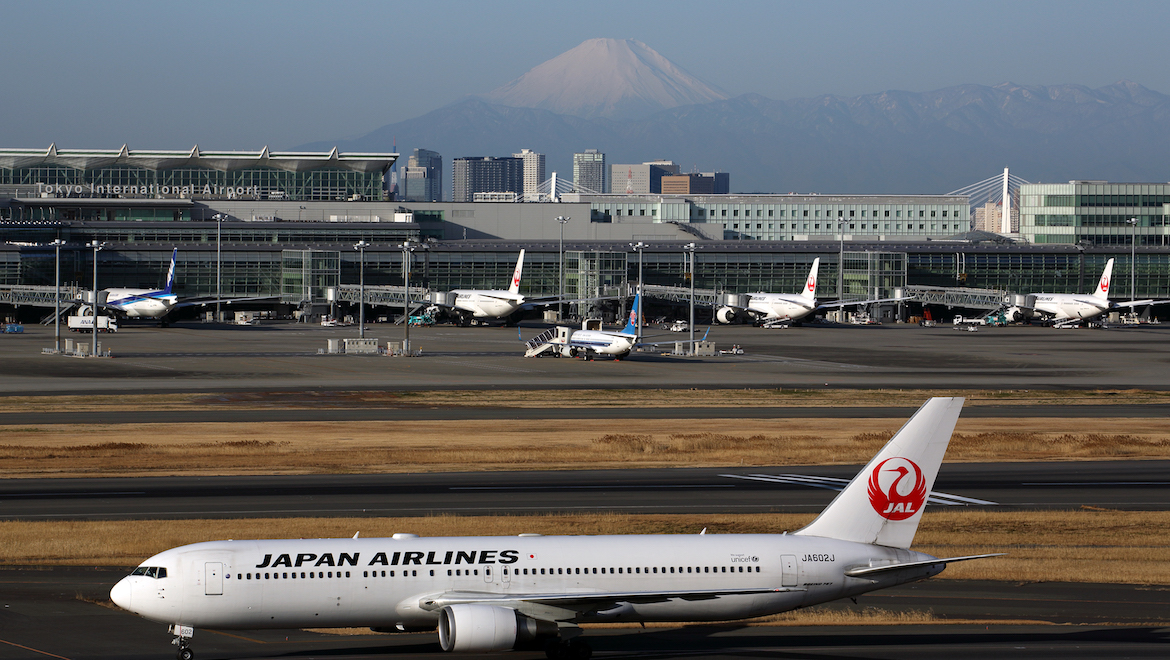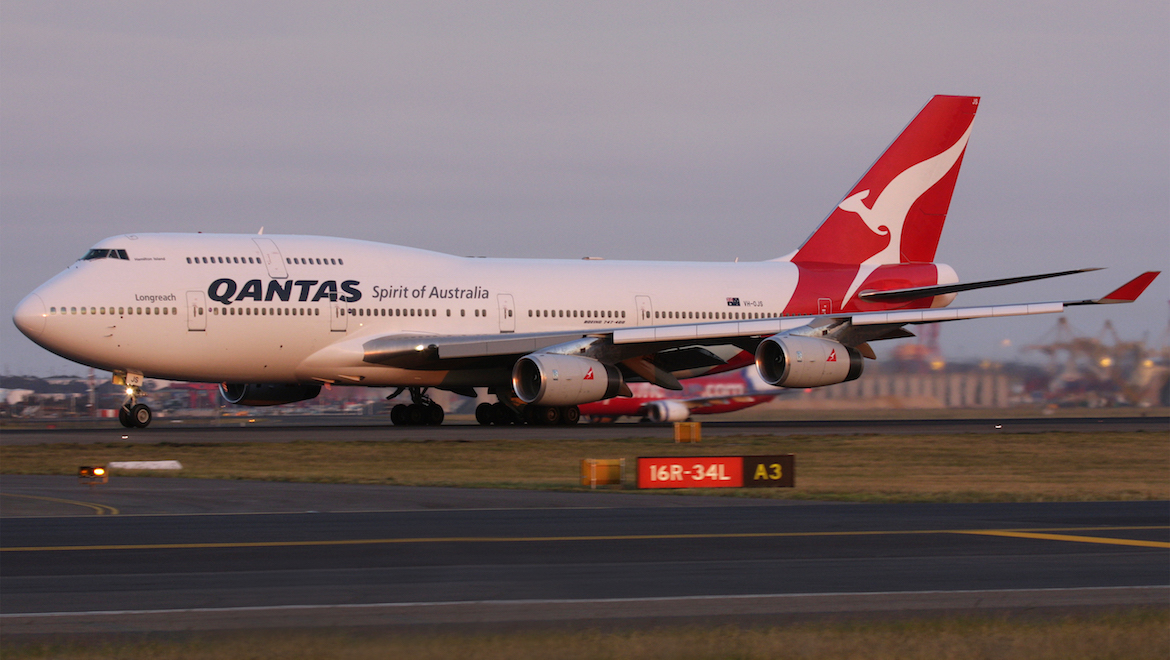
Virgin Australia has emerged with a share of the spoils in the battle with Qantas to secure highly sought after slots to serve Tokyo Haneda Airport.
Australia’s International Air Services Commission (IASC) said in a draft determination published on Monday it had awarded Virgin Australia one of the two available slots for nonstop flights between Australia and Tokyo Haneda.
The decision paved the way for Virgin Australia to commence nonstop Brisbane-Tokyo Haneda flights with Airbus A330-200s configured with 20 business class seats offering direct aisle access for each passenger and 255 economy seats at eight abreast from the end of March 2020.
While Qantas also received one slot, the airline had sought both available slots to expand its presence in the Australia-Japan market by adding a second daily Sydney-Tokyo Haneda flight and switching its Melbourne-Tokyo Narita service to Haneda.
The IASC, which manages Australia’s international traffic rights, said granting Virgin Australia and Qantas one slot each would offer the greatest benefit to the public.
“A competitive environment on the route in question (Japan-Australia) will most likely be fostered by the allocation of one frequency to Qantas and one to Virgin Australia,” the IASC draft determination said.
Virgin Australia said in its submission its daily Brisbane-Tokyo Haneda service would be operated in partnership with Japan’s All Nippon Airways (ANA), with the two carriers to codeshare on each other’s flights between Australia and Japan. The IASC has approved the codeshare.
Virgin Australia said it was excited to begin flights to Tokyo Haneda and “bring strong competition and choice to the market”.
“We’re pleased that the International Air Services Commission has issued a draft determination, proposing to award Virgin Australia with one of the daily frequencies to Haneda, Japan,” the airline said in a statement on Monday.
“We can’t wait to provide guests with the best value fares and our unique Virgin experience to Japan.”
The airline’s application was supported by, among others, Brisbane Airport, Tourism Australia and the Australian Competition and Consumer Commission (ACCC), which told the IASC it believed giving one slot to both Virgin Australia and Qantas would “promote competition to a much greater extent than allocating both frequencies to Qantas”.
The IASC said in its draft determination it agreed with the ACCC view.
“If the commission granted both frequencies to Qantas, and refused Virgin Australia’s application, the Australia-Japan route would be likely to gain only one incremental frequency from Sydney (already served by three airlines),” the draft determination said.
“Qantas would be unlikely to gain a competitor on the route to and from Brisbane, and only two Australian cities (Sydney and Melbourne) would be likely linked to Haneda.”

In September, the Japanese Ministry of Land, Infrastructure, Transport and Tourism (MLIT) allocated a total of four new slot pairs for Australia-Tokyo Haneda routes, comprising two new slot pairs for Japanese carriers – one for All Nippon Airways (ANA) and one for Japan Airlines – and two new slot pairs for Australian carriers.
The allocation was among a package of 50 slot pairs for international services at Tokyo Haneda, with 25 for Japanese airlines and 25 for international carriers.
Also, the slots would be for daytime services – notionally between 0600 and 2255 – as air traffic managers opened up more airspace in the Tokyo area to support the additional flights.
Tokyo Haneda Airport, which is located much closer to Tokyo city than Tokyo Narita, had previously been predominantly used by Japanese carriers as a domestic airport.
However, there have been efforts to expand the number of international services at Haneda amid a Japanese government push to attract more tourists to the country.
Currently, there were nine nonstop routes between Australia and Japan operated by four carriers – Sydney-Tokyo Haneda (ANA and Qantas), Sydney-Tokyo Narita (Japan Airlines), Sydney-Osaka Kansai (Qantas), Melbourne-Tokyo Narita (Japan Airlines and Qantas), Brisbane-Tokyo Narita (Qantas), Gold Coast-Tokyo Narita (Jetstar), Cairns-Osaka Kansai (Jetstar), Cairns-Tokyo Narita (Jetstar) and the recently commenced Perth-Tokyo Narita service from ANA.
And there is new capacity coming later in 2019, with Qantas scheduled to operate a seasonal Sydney-Sapporo nonstop flight with Airbus A330 equipment between December 2019 and March 2020.

Qantas had raised questions in its application about Virgin Australia’s capability to be ready to begin flights by the end of March 2020, arguing it was the “only no risk option” to meet the requirement for the two Tokyo Haneda slots to be utilised from March 29 2020.
Virgin Australia described those concerns as “mere conjecture”, arguing it was well placed to begin flights by the end of March.
Further, Australia’s Department of Infrastructure, Transport, Cities and Regional Development said Virgin Australia was “reasonably capable of obtaining the relevant licences, permits and other approvals required” to fly to Tokyo Haneda.
The IASC draft determination said Virgin Australia’s commercial-in-confidence submission provided information on the scope of work it had undertaken so far to ensure all operational and regulatory processes were met, enabling the airline to operate the route within tight timeframes.
It said Virgin Australia had also provided confidential information as to how it would operate and sustain air passenger services between Brisbane and Tokyo Haneda.
“The commission is of the view there is no regulatory impediment for Virgin Australia to apply for a slot allocation from the Japanese civil aviation authorities in order to operate services between Brisbane and Haneda,” the draft determination said.

Qantas said it would determine which route it would use the one slot it had been allocated once the IASC had completed its work issued a final determination.
“We look forward to adding even more flights from Australia to Haneda Airport,” Qantas said in a statement on Monday.
“We’ll confirm whether these flights will operate from Melbourne or Sydney shortly.”
The IASC said the closing date for submissions in response to the draft determination was October 24.
















Phil
says:It would be smart if Qantas prioritised Melbourne over a 2nd Sydney flight because ANA will most likely be launching flights to Melbourne from Haneda sometime soon. If QF needed a 2nd Sydney to Haneda flight so badly I’m sure they could make an agreement with JAL where they could use their slot for a Sydney-Haneda flight and Qantas could codeshare on it.
Lechuga
says:Hopefully Qantas upgrade Melbourne to HND. Innsaying that if there was a chance to fly JL or NH to Haneda from Melbourne I’ll take that over QF for sure.
Rod Pickin
says:Congratulations Virgin Australia, I am sure that you will do the country proud!; – probably not what you wanted at this time but go getum folks.
Scott
says:That’s a win there for Virgin, common sense from the IASC, fantastic result combined with a brilliant product on Virgins 330’s and partnership with powerhouse ANA, the route & partnership should perform well over the coming years.
Gives more of the travelling public options to experience Virgins widebody product internationally on another long haul route to a great destination, which will be a huge positive for them and attract more domestic customers Virgins way.
Hutch
says:@Phil – I wouldn’t agree that is smart, but I certainly think it is an option.
One thing I think QF will be very keen to achieve is improving fleet usage. It is one thing to have an old 747 sitting in Tokyo all day, its another thing to have a 787 sitting there. By using the second slot for SYD – HND, it will enable QF not to have an airplane sitting on the tarmac all day. Arguably, the same can be achieved by flying MEL – HND daytime both ways, with SYD – HND overnight both ways (ie a SYD-HND-MEL, MEL-HND-SYD routing). While possible and it benefits with the a lack of a curfew at MEL, QF would need to rejig a few things to find a use for that plane overnight once in MEL- if a 787, a late flight to West Coast North America is an option, but there are certainly a few things to consider.
While you are right that QF could talk with JAL to use their slot to fly HND-SYD and QF could apply for a codeshare (more chance to be approved now with the VA/ANA partnership), they could also get them to fly HND-MEL and codeshare on that.
Phil
says:The reason why I said it was wise for QF to prioritize MEL was because the question is does Qantas really want to risk losing Melbourne customers to ANA? And does SYD really need 4 daily flights to HND?
Hutch
says:@Phil – Melbourne customers v increased fleet utilisation. Given that QF didn’t serve MEL – NRT until a few years, I’m not sure QF really prioritises it that much… But who knows, they may very well go that way.
Though I don’t think the airport you fly into (assuming ANA flies into MEL from HND and QF doesn’t) will cost QF all their Melbourne customers. Some for sure. But airport alone is not the deciding factor on flights for everyone. If it was, we will see JAL drop MEL and QF drop BNE-NRT as they will have no passengers.
Red Cee
says:This was the most likely outcome. If Qantas uses it’s slot for a Melbourne service, there will be daily services from the three major cities on an Australian airline. If Qantas chooses a second service from Sydney, it will be unfair, as Melbourne will miss out on a daily service direct to HND, which may force some people who will only travel on the most direct service to fly on the direct ANA service.
Johno
says:Business is not about being fair.
Liam
says:The reason Qantas wants to fly a second SYD-HND flight is because Sydney is Qantas’s headquarters
teiemka e
says:@Liam planes fly where they are likely to make you the most money, home town sentimentality is never a consideration.